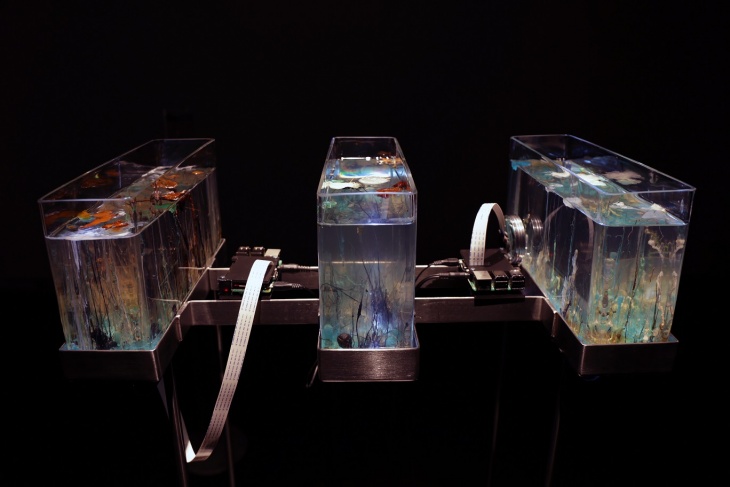Robertina Šebjanič, Aleš Hieng – Zergon and Ida Hiršenfelder: Time Displacement: Chemobrionic Garden
Durational performance and sound installation in an open laboratory
Vsebina
About the project
Time Displacement / Chemobrionic Garden is an interactive generative chemical sound installation, which explores a relationship between hydrothermal chemistry, the passage of time, and sensory systems tracing changes outside of the human scale.
Artists created an installment comprised of several small chemical garden formations in a water glass (sodium metasilicate) solution, to provide an insight into research on the origin of life and on chemical processes. The project’s theoretical background is based on a paper entitled From chemical gardens to chemobrionics, written and issued by a group of 21 distinguished scientists on 29 May 2015, a reiterating call for research into the principles of self-assembling structures, to produce – as they suggest – new insights into the origin of metabolism in Earth’s early geological periods.
The chemical reactions are monitored by cameras to detect changes in colour and in shape by means of a microcontrollers. The changes affect the code for live sound generation, and slowly work to alter the generative drone composition pervading the gallery space. It goes beyond the human perception of time. It calls for a perspective that considers multiple dimensions of temporal rhythms in space with slow modulation beyond the spectrum audible to the human ear.
The core proposition of this piece is to create a situation in which the growth of chemical structures takes the centre stage. The human expectations are put in the background in order to stimulate a state of altered listening in which one is exposed to the geological passage of time.
The antagonism between the human and the Earth’s processes is a direct result of anthropocentric perspective. In the age of anthropocene we need a radical shift in perspective if we are to survive as a species. Scientists are on a new quest to find in these abiotic formations the root of biotic protocells. In addition, Time Displacement poses a question of giving way to life by means of shifting ways of sensing. The question of the origin of life inevitably seeks to ask the question of finite nature of life forms themselves. The colourful biomimetic morphologies of chemical gardens are a fascinating imitation of life. In the last few centuries, chemical gardens have progressed from being a counterfeit of biotic life to being the original; from childlike imitations of life to the sheer origin of life on Earth.
Conceptual background
The colourful biomimetic morphologies of chemical gardens are a fascinating imitation of life. Key to these marvellous structures, which spent decades locked away in an alchemist’s cabinet of curiosities, is a renewed study of chemobrionics, a field combining chemistry, physics, biology, and materials science. Chemobrionics denotes self-propagation, the growth of chemical structures with a tendency to increase concentration gradients under conditions of osmotic pressure and buoyancy. Scientists are on a new quest to find in these abiotic formations the root of biotic protocells. Therefore, in the last few centuries, chemical gardens have progressed from being counterfeit to being original; from childlike imitations of life to the sheer origin of life on Earth.
Time Displacement is a durational performance which uses chemical gardens as stained glass windows to explore the optics that change the cultural perception of the world and the practice of differentiating between organic and inorganic matter. This changed perception of matter is made possible by means of interdisciplinary research, which contributes to a more holistic understanding of (geological, chemical, social, political) processes in the world. Although not a new notion, chemical gardens are only now emerging as an unexpected research area and a prime example in chemistry of self-organising non-equilibrium processes that create complex structures, combining chemistry, fluid dynamics, and materials science. If research in the field of chemobrionics is legitimated by the development of new materials for commercial purposes, Time Displacement encourages such study of materials, which maintains a fascination with the potential development of nanomaterials without any commercial implications. A durational performance in an open laboratory, Time Displacement takes the viewpoint of the history of science to talk about findings which are not just a result of meticulous research, but also a product of the cultural environment.
Used also a starting point for chemical-acoustic live experiments, the installation will be comprised of several small chemical garden formations in a water glass (sodium metasilicate) solution, to provide an insight into research on the origin of life and on chemical processes, which unfold at apace that is rapid,yet still too slow to be discernible to the naked eye. The chemical reactions, where visible changes take between 8 and 48 hours, will be monitored by cameras to detect changes in colour and in shape by means of a microcontroller. The changes will affect the code for live sound generation, and will slowly work to alter the harmony pervading the gallery space. A sound art installation which goes beyond the human perception of time calls for a perspective that considers the multiple dimensions of temporal rhythms in space.
Text by Ida Hiršenfelder.
 (Note: Chemobrionics is a term denoting an interdisciplinary field at the intersection of chemistry, physics, biology, and materials science. From the paperFrom chemical gardens to chemobrionics, (29 May 2015), a work of 21 scientists from around the world.)
(Note: Chemobrionics is a term denoting an interdisciplinary field at the intersection of chemistry, physics, biology, and materials science. From the paperFrom chemical gardens to chemobrionics, (29 May 2015), a work of 21 scientists from around the world.)
Past events
- Festival IZIS #7 Monfort, Portorož | 5th - 26th July, 2019
- Experiment Future group exhibition, Kunsthalle Rostock, DE | March 23rd – May 5th, 2019
- esc medien kunst labor, Graz, AT | May 4th – June 29th, 2018
- Solo exhibition, Simulaker Gallery, Novo mesto | 5 – 27 May 2017
- Solo exhibition, Močvara Gallery, Zagreb, HR | 20 – 23 March 2017
- Radical Atoms Exhibition, Ars Electronica | 8 – 12 September 2016
- Device_art 5.016, Eastern Bloc, Montreal, Canada | May 12 – June 1 2016
- Aksioma project space, Komenskega 18, Ljubljana | 17 – 19 December 2015
Programme in Asioma
Lecture – Chemobrionics: From the origin of life to nanomaterials of the future
Thursday 17 December 2015 at 7 pm
The lecture will employ the methods of a botanic garden tour. It will be based on (From chemical gardens to chemobrionics), a paper from May 2015 which restores the role of chemical gardens at the outsetof synthetic biology. The scientists behind the paper suggest the term chemobrionics, blurring the boundaries between inorganic and organic chemistry, and proposing a number of methods for the study of new materials. In the lecture, the frames of reference for an interpretation of Time Displacement will include a criticism of science, an analysis of live-generated visual audio structures, and science fiction.
Open laboratory
Friday 18 December, and Saturday 19 December 2015, 1 to 8 pm
The durational performance in an open laboratory has been designed for the general public and scientists to learn about the principles of osmotic forces and crystal growing procedures. In the laboratory, visitors will be able to conduct an osmosis experiment in a saline solution, with chemical compounds such as sodium silicate, sodium acetate, calcium chloride, copper(II) sulfate, iron(III) chloride, chromium(II) chloride, iron(II) sulfate, cobalt(II) chloride, potassium aluminium sulfate, manganese(II) chloride, nickel(II) sulfate. The audience will also learn about live-generated music with slow modulation beyond the spectrum audible to the human ear.
About authors
Robertina Šebjanič is an new media artist and cultural facilitator. In her art practice she is interested in humanist and natural science in the context of Bio-Art, AV performances and installation's within the context of contemporary art practice. Her ideas and concepts are often realized in collaboration with other authors, and thus through interdisciplinary and informal integration embodies in her work.
Aleš Hieng – Zergon is a chemical engineer and a musical performer. His improvised live performances are characterised by analogue and modulated sounds and noises combined with field recordings, as well as by the use of DIY electronic sound devices.
Ida Hiršenfelder is a media art critic, curator for media art and theorist. Since 2014 she is a collaborator of MG+MSUM Museum of Contemporary Art Metelkova for Network Museum online aggregator of contemporary art archives. From 2007 to 2013 she was a digital archivist for DIVA Station, Digital Video Art Archive at SCCA, Centre for Contemporary Arts-Ljubljana, a member of GAMA, Gateway to Archives of Media Art European network.
Credits
Authors: Robertina Šebjanič, Aleš Hieng – Zergon, Ida Hiršenfelder
Programming: Slavko Glamočanin
Technical support: Valter Udovičić
Production: Zavod Projekt Atol (Uroš Veber) and Ljudmila, Art and Science Laboratory (Tina Dolinšek)
Co-production: Aksioma Institute
Special thanks to: SCCA - Ljubljana Centre for Contemporary Arts, Aksioma team (Janez Janša, Marcela Okretič, Sonja Grdina, Hana Ostan Ožbolt, Valter Udovičić), Roman B.
In 2016 project got nominated for the STARTS – Grand prize of the European Commission honoring Innovation in Technology, Industry and Society stimulated by the Arts.
Project was supported by the Slovene Ministry of Culture and MOL – Department for Culture.
